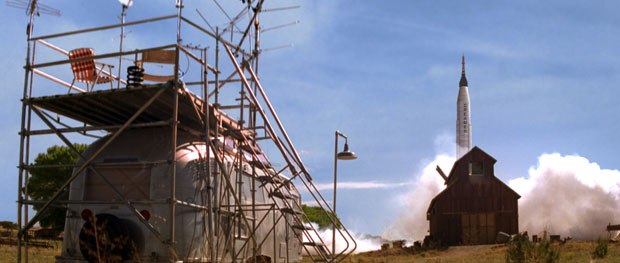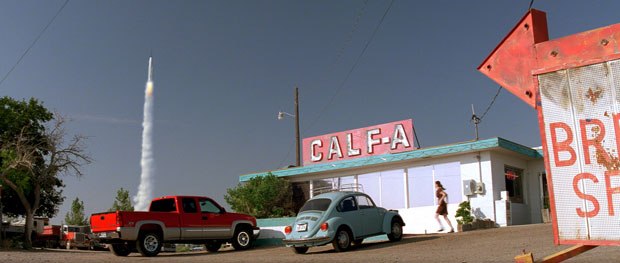Thomas J. McLean discovers that theres more vfx to The Astronaut Farmer than meets the eye, including CG work involving the rocket ship and its orbit around the Earth.
The Astronaut Farmer (opening Feb. 23 from Warner Bros. Pictures) may be a small-budget film, but its story of an ex-space jockey who builds a rocket in his garage so he can fulfill his dream of going into outer space has some significant vfx requirements.
Directed by Michael Polish from a script he wrote with his twin brother Mark, the film stars Billy Bob Thornton as Charlie Farmer, a one-time space program candidate who bowed out of the program for personal reasons but refuses to give up on space travel. Farmer builds a rocket in the barn of his Texas ranch and is nearly ready to launch it and himself into orbit, when his attempts to buy 10,000 pounds of rocket fuel turns the attention of the federal government and the media on his farm and family. With the ranch on the verge of bankruptcy and the government threatening to stop his flight, Farmer is forced to go ahead with the launch or risk losing his dream.
Though the family film was small, it had one distinct challenge for the visual effects crew, which was supervised by Jason Piccioni. We took a look at it and immediately realized we had a $10 million movie where the third act takes place in space, he says.

With a modest budget, good preparation was key. Piccioni says they obtained real space footage from NASAs Mercury era, which roughly parallels the technology Farmer uses in the film, and edited it into a reel that followed the storyboards as closely as possible. That allowed director Polish to shape the sequence before any effects were done or footage was shot of Thornton in the space capsule.
The brothers were very, very collaborative in everything that they wanted to do, Piccioni insists.
Most of the effects work pertains to the two rocket launch sequences and Farmers space journey. At first, Farmer launches the rocket before its truly ready. It gets off the ground, but quickly tips over and flies out of control over the landscape. The crash leaves Farmer battered and bruised, both physically and emotionally.
Piccioni says the sequence went through a good deal of direction from the Polish brothers, who originally had intended it to be funny, floating ideas such as the ship leaving a rocket-shaped hole in a house like in old cartoons.
We had to monkey around with it to get some shots that looked visually pleasing, Piccioni explains. We wanted to illustrate the danger and bang him around a little bit. We had trouble believing he wasnt getting killed. That actually took a little bit of effort.
The largest effects sequence is the third act, in which Farmer successfully launches his rebuilt rocket into space, orbits the Earth and re-enters the atmosphere for a safe return home. While a prop rocket was built on set, it took Maya to make it fly and to create the CG images of the Earth. Piccioni says the background images of the stars were done in Photoshop.
There were some additional, supporting effects done in a scene in which the rocket blast shatters the windows in the Farmer ranch house, on a few of the monitors in NASA mission control, and adding to the mob of press gathered at the ranch to observe the launch.
Piccioni had three facilities working on the film: Warner Bros. Animation, Cafe FX and Pacific Title. WB Animation did the brunt of the work, including all of the previs; they built the rocket and most of the shots. Cafe FX did about 10 extra shots of the rocket during lift off and into orbit.
Pac Title came in at the end and did some smaller effects and reshoots, such as adding to the media circus.
The schedule was unusual, too. Piccioni says the film finished shooting in November 2005 and work began right away on the space sequences, running for 12 weeks to get a rough cut. They then scaled down and left the project while the film was edited and came back in August and September of 2006 to finish it up.

The film originally was to have between 100 and 125 effects shots, a number that rose to nearly 200 as the film progressed and the crew was given permission to add touches such as a reflection to the shield of Thorntons helmet. These are the kind of things that came up as the movie starts to test well and the studio loosens up with the money, Piccioni suggests.
Shot in New Mexico, Piccioni says the visual effects crew had someone on set every day, and even did some second unit work on shots such as the capsule crash site.
Piccioni says the film offered a change of pace from the larger films he was working on, such as Invasion, and he enjoyed the camaraderie of the shoot and the simplicity of making a small, family-friendly feature.
Im kind of proud of the work we did in being as efficient as possible and eliminating the little things that drive budgets crazy, he adds. Its about making a movie. Every effort that happened out there, you see on the screen.
Thomas J. McLean is a freelance journalist who specializes in writing about visual effects, Oscars, TV, comic books, games and technology. His writes the Bags and Boards blog on the comic book industry for Variety.com at. His first book, X-Men: The Movie Trilogy and the Comics will be published in March 2007 by Sequart.com Books.









